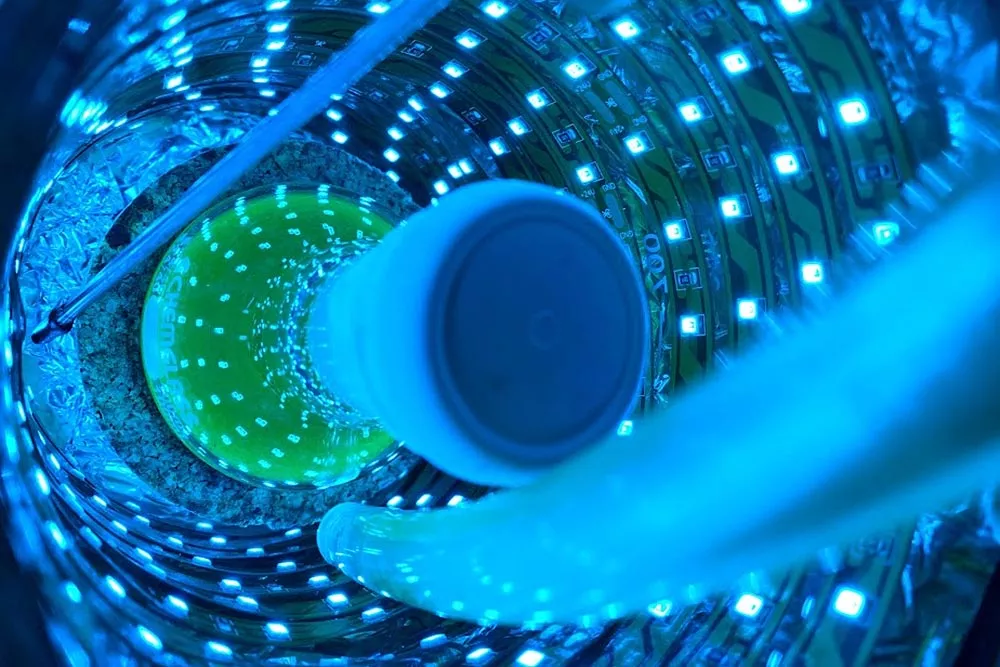
Light driven chemical reactions provide a powerful tool for chemists to develop new methods for the production of drugs and other important molecules. The use of this light energy requires photooxidation catalysts, which can absorb light and transfer energy to chemical reactions.
Now, MIT chemists have designed a new type of photooxidation catalyst, which can make the light driven reaction easier to be incorporated into the manufacturing process. Unlike most existing photocatalysts, these new materials are insoluble, which means they can be reused. This catalyst can be used to coat the tube and chemically convert the reaction stream as it passes through the tube.
"Recycling catalyst is one of the biggest challenges to use photocatalysis in the manufacturing industry. It needs to be overcome," said Richard Liu, a postdoctoral fellow at MIT and co-author of this new study. "We hope that by using immobilized catalyst for flow chemical reaction, we can provide a new way to carry out larger-scale photocatalysis."
It is understood that this new catalyst can be adjusted to carry out many different types of reactions. In addition, it can also be incorporated into other materials, including textiles or particles.
It is reported that Timothy swager, Professor of chemistry at MIT John D. MacArthur, is the senior author of this paper, which was published in nature communication on may27,2022. In addition, Sheng Guo, a research scientist of the college, and Shao Xiong Lennon Luo, a graduate student, are also the authors of the paper.
Mixed materials
The working principle of photooxidant catalyst is to absorb photons, and then use light energy to provide power for chemical reactions, which is similar to how chlorophyll in plant cells absorbs energy from the sun and uses it to build sugar molecules.
Chemists have developed two kinds of photooxidation catalysts, which are called homogeneous catalysts and heterogeneous catalysts. Homogeneous catalysts are usually composed of organic dyes or light absorbing metal complexes. These catalysts are easy to adjust for specific reactions, but the disadvantage is that they will dissolve in the reaction solution. This means that they are not easy to remove and reuse.
On the other hand, heterogeneous catalysts are solid minerals or crystalline materials that form lamellar or three-dimensional structures. These materials do not dissolve, so they can be used many times. However, these catalysts are more difficult to adjust to achieve the desired reaction.
In order to combine the advantages of these two types of catalysts, the researchers decided to embed the dye constituting the homogeneous catalyst into a solid polymer. For this application, the researchers modified a plastic like polymer with tiny pores. In this study, the researchers proved that they can incorporate about a dozen different homogeneous catalysts into their new hybrid materials, but they believe that it can work more.
Liu said, "these mixed catalysts have the recyclability and durability of heterogeneous catalysts, but also have the precise adjustability of homogeneous catalysts. You can add dyes without losing chemical activity, so you can more or less select and obtain the insoluble equivalent of the catalyst you need from the tens of thousands of known photooxidation reactions."
Researchers have found that incorporating catalysts into polymers also helps them become more efficient. One reason is that the reactant molecules can be contained in the pores of the polymer, ready to react. In addition, light energy can easily move along the polymer to find the waiting reactant.
Swager said, "new polymers combine molecules in solution and effectively pre concentrate them for reaction. In addition, excited states can migrate rapidly throughout the polymer. The mobility of excited states and the partition of reactants in the polymer combine to make the reaction faster and more effective than the reaction that may occur in pure solution."
Higher efficiency
The researchers also showed that they can adjust the physical properties of the polymer skeleton, including its thickness and porosity, according to the application of the catalyst they want to use.
As an example, they show that they can produce fluorinated polymers that can adhere to fluorinated tubes, which are usually used for continuous flow manufacturing. In this type of manufacturing process, chemical reaction flows through a series of tubes while adding new components or performing other steps, such as purification or separation.
At present, it is challenging to incorporate the photooxidation reaction into the continuous flow process, because the catalyst will soon run out, so it must be added to the solution continuously. The new catalyst designed by MIT can be incorporated into the pipeline used for this production, so that the photooxidation reaction can be carried out in a continuous flow. The tubes are transparent and allow light from the LEDs to reach the catalyst and activate them.
"Our idea is to paint the catalyst on the tube, so you can let your reaction flow through the tube while the catalyst stays still. In this way, you will never see the catalyst in the product, and you can get higher efficiency," Liu said.
In addition, the catalyst can also be used to coat the magnetic beads, so that they can be easily pulled out of the solution or coated on the reaction bottle or textiles after the reaction. Researchers are now working to incorporate more types of catalysts into their polymers and engineering the polymers to optimize their different possible applications.